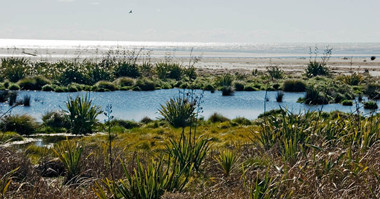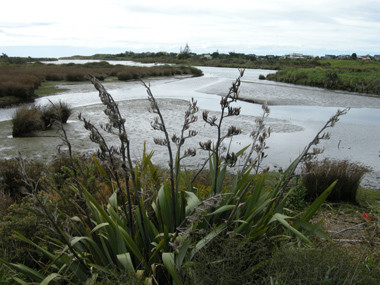 Waikanae Estuary, Kapiti District. Photographer: Jeremy Rolfe.Estuaries are tidal reaches and mouths of coastal rivers, coastal lagoons and wet habitat of open, or temporarily closed, coasts where sea water is diluted by land drainage and where tidal effects are evident.
Waikanae Estuary, Kapiti District. Photographer: Jeremy Rolfe.Estuaries are tidal reaches and mouths of coastal rivers, coastal lagoons and wet habitat of open, or temporarily closed, coasts where sea water is diluted by land drainage and where tidal effects are evident.
They are a type of wetland but the key characteristic is that all estuarine environments share a mixing of fresh and saline waters in the coastal environment.
There are four main estuarine forms:
- Estuary - Semi-enclosed body of water having a free connection with the open sea with channel complexes that drain during low tide
- Estuary (tidal river mouth) - River or stream mouth which has a free connection with the open sea. (Lacking a true estuary form, i.e. semi-enclosed body of water)
- River mouth lagoon (hapua) - Generally coast-parallel bodies of predominantly fresh water impounded by a long narrow spit formed by long shore drift offsetting at a river mouth
- Coastal lake/ lagoon - Exceedingly ‘choked’ with respect to exchanges of water with the ocean via an inlet or inlets, with openings to the sea rare and short-lived unless created by human action
 Waikanae Estuary. Photographer: John Sawyer.For more information:
Waikanae Estuary. Photographer: John Sawyer.For more information:
For more information about estuaries see*:
- The life of an Estuary (NIWA)
- The Estuary ecosystem- Te Ara Encyclopedia
- Plants of the estuary- Te Ara Encyclopedia
- Estuary (Wikipedia)
- Waikanae Estuary - Watch the TVNZ / DOC Meet the Locals film
*The Network is not responsible for the content of external internet sites
